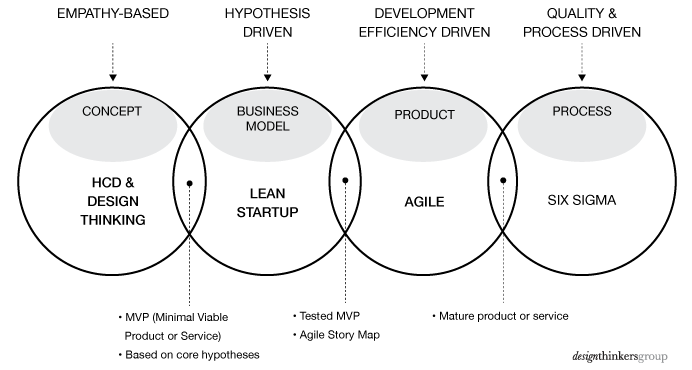Design & Development
Iterative development and delivery, discover prototyping techniques
Here, you'll delve into the creation process. Explore best practices for User Interface (UI) design to create user-friendly interfaces and Information Architecture to ensure optimal content organization. Learn about Agile development methodologies for iterative development and delivery, discover prototyping techniques to validate design concepts, and gain insights into usability testing best practices to evaluate user interaction with your product.
Design Thinking
Empathize: Understand the user through research and observation.
Define: Synthesize research to define the core problem.
Ideate: Generate a wide range of ideas and solutions.
Prototype: Create low-fidelity prototypes to explore solutions.
Test: Test prototypes with users to gather feedback and iterate.
Lean UX Canvas
Business Problem Statement: Define the business problem you are addressing.
User Segments: Identify the target user segments.
Outcomes and Benefits: Specify the desired outcomes and benefits for users.
Solutions: Propose potential solutions to the problem.
Hypotheses: Formulate hypotheses to be tested.
Assumptions: List assumptions that need validation.
Experiments: Design experiments to test hypotheses.
Results and Insights: Collect and analyze results to gain insights.
Key Differences
Focus: Design Thinking emphasizes understanding and solving user problems through empathy and creativity, while Lean UX Canvas focuses on validating business hypotheses through iterative testing and learning.
Process: Design Thinking follows a more linear process from empathy to testing, whereas Lean UX Canvas is cyclical, emphasizing continuous iteration and feedback.
Tools: Design Thinking uses tools like empathy maps, personas, and journey maps, while Lean UX Canvas uses structured templates to capture and test assumptions and hypotheses.
Key Similarities
User-Centric: Both methodologies prioritize the needs and experiences of the end-user.
Iterative: Both involve iterative processes to refine and improve solutions based on user feedback.
Collaboration: Both encourage cross-functional collaboration to leverage diverse perspectives.
Design Thinking vs. Lean UX Canvas




